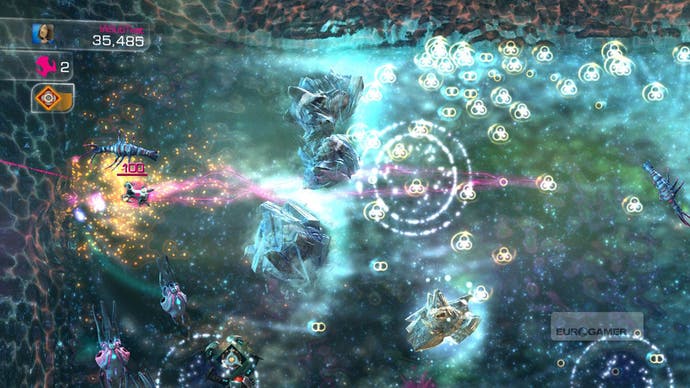Ion Assault
Splash damage.
With the right timing and a bit of luck, blasts rebound off enemies or asteroids and can be collected again instantly, minimising your craft's exposure. Alternatively, firepower can be concentrated in the corners, where it's more likely to pool than dissipate. This resource-management is a vital skill-step on the path to success, and it's upon realising this that the game clicks. By forcing this continuous planned movement into areas rich with ions, the central mechanics of enemy avoidance and accurate shooting are further integrated and intensified - a synergy of parts that adds surprising depth. As with many of the best quirky mechanics, it becomes such second nature that you'll wonder why it's not been done before.
To finish a level players must destroy all of the stage's asteroids, each of which divides into smaller parts. Destroying part of an asteroid, or one of the aliens, releases a score orb, with double and triple orbs released when two or more enemies are destroyed with a single shot. Collecting these starts a multiplier, storied by an obvious counter just above your ship. Keep picking up orbs and the multiplier stays alive and increases. Let it die and the score is calculated and accumulated, with extra lives coming every 100,000. This adds another layer of strategy. Orbs disappear before long, so judging the best point to start scooping them up and multiplying is key. When you inevitably lose your last life, it's simply a matter of restarting the stage with a zero score rather than heading back to the first area.
It looks beautiful, too. Decoration is limited, but each space has a strong colour theme and distinctive enemies, and the end-of-area bosses are colourfully executed if not original. The particle effects are the real star of the show, though. The bright cascades of light that slosh around the play area are hypnotic, and the increasing thrum of your weaponry as ions are drawn into your gravity well is exhilarating. These distractions cause more than a few deaths, but that's sort of the point - narrowing your information aperture to keep track of the important details in a storm of data is just one of the skills you need to hone.

Ion Assault isn't a long game. There are just over 20 levels for the single player, which last a couple of hours on regular difficulty, even if you're not particularly good at this sort thing. Playing at that sort of pace would be a little gluttonous, though, not to mention exhausting. This is a game for brief half-hour bursts; for zoning out until you're blinking splinters. It's cathartic and oddly relaxing.
It's also obviously a game designed for replays - score leaderboards let you know just how much you suck, whilst the co-operative muliplayer increases the excess visual information and resource management even further. There's also a Versus multiplayer option, but it dumps the main particle schtick in favour of an overheating mechanism for weaponry, and in doing so loses most of its individuality.
Ion Assault is an extremely polished and well-executed twist on a very pure gaming genre. At 800 Microsoft Points (£6.80 / €9.60), it's perhaps a little bit pricey for those who'll only play it once, but get a few mates involved in some friendly leaderboard rivalry and the replay value goes right up. Moments of grace indeed.
